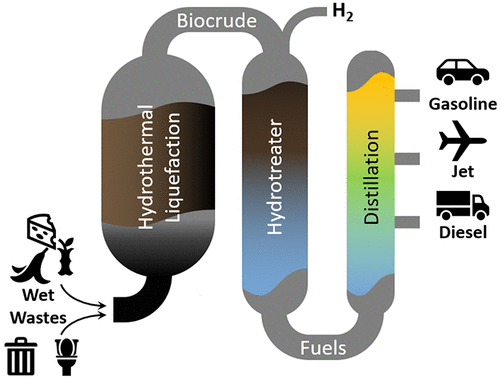当前位置:
X-MOL 学术
›
ACS Sustain. Chem. Eng.
›
论文详情
Our official English website, www.x-mol.net, welcomes your
feedback! (Note: you will need to create a separate account there.)
Extended Catalyst Lifetime Testing for HTL Biocrude Hydrotreating to Produce Fuel Blendstocks from Wet Wastes
ACS Sustainable Chemistry & Engineering ( IF 7.1 ) Pub Date : 2021-09-13 , DOI: 10.1021/acssuschemeng.1c02743 Senthil Subramaniam 1 , Daniel M. Santosa 1 , Casper Brady 1 , Marie Swita 1 , Karthikeyan K. Ramasamy 1 , Michael R. Thorson 1
ACS Sustainable Chemistry & Engineering ( IF 7.1 ) Pub Date : 2021-09-13 , DOI: 10.1021/acssuschemeng.1c02743 Senthil Subramaniam 1 , Daniel M. Santosa 1 , Casper Brady 1 , Marie Swita 1 , Karthikeyan K. Ramasamy 1 , Michael R. Thorson 1
Affiliation

|
This paper reports on the catalyst stability of the hydrotreatment of HTL (Hydrothermal Liquefaction) biocrudes to produce finished liquid transportation fuel blendstocks. We report the stable hydrotreating of HTL biocrude derived from sewage sludge and food waste over industrially relevant hydrotreating CoMo and NiMo catalysts at relevant catalyst activities. The use of wet-waste-derived HTL biocrudes derived from both food waste and sewage sludge in the hydrotreater campaign strengthens the case that HTL biocrudes derived from a variety of wet-waste feedstocks can be upgraded without significant catalyst instability over industrially relevant hydrotreater time-periods. Stable hydrotreating performance was obtained with each feedstock. The overall yield was approximately 85% with all HTL biocrudes. Over 1500 h of steady-state operation, minimal deactivation was observed. These results indicate that a hydrotreatment process to upgrade can be stable for industrially relevant times, a critical roadblock to derisking commercialization. The upgraded product produces a diesel-rich (∼70% in the 150–350 °C range) fuel blendstock, with high cetane due to the high fraction of alkanes. Further, we report the impact of process levers on hydrotreating performance on a fully broken-in catalyst (following 1500 h of steady-state operation). The long-term catalyst stability presented here is an important demonstration to derisk HTL commercialization.
中文翻译:

用于 HTL 生物原油加氢处理以从湿废物生产燃料混合物的延长催化剂寿命测试
本文报告了对 HTL(水热液化)生物原油进行加氢处理以生产成品液体运输燃料混合原料的催化剂稳定性。我们报告了在相关催化剂活性下,通过工业相关加氢处理 CoMo 和 NiMo 催化剂对源自污水污泥和食物垃圾的 HTL 生物原油进行稳定加氢处理。在加氢处理器活动中使用源自食物垃圾和污水污泥的湿废物衍生 HTL 生物原油加强了这样的情况,即源自各种湿废物原料的 HTL 生物原油可以升级,而不会在工业相关的加氢处理器时间内出现明显的催化剂不稳定性-期间。每种原料都获得了稳定的加氢处理性能。所有 HTL 生物原油的总收率约为 85%。超过 1500 小时的稳态运行,观察到最小的失活。这些结果表明,要升级的加氢处理工艺可以在工业相关时期保持稳定,这是降低商业化风险的关键障碍。升级后的产品生产出富含柴油(约 70% 在 150-350 °C 范围内)的燃料混合原料,由于烷烃含量高,十六烷值高。此外,我们报告了工艺杠杆对完全磨合的催化剂(稳态运行 1500 小时后)的加氢处理性能的影响。这里介绍的长期催化剂稳定性是降低 HTL 商业化风险的重要证明。升级后的产品生产出富含柴油(约 70% 在 150-350 °C 范围内)的燃料混合原料,由于烷烃含量高,十六烷值高。此外,我们报告了工艺杠杆对完全磨合的催化剂(稳态运行 1500 小时后)的加氢处理性能的影响。这里介绍的长期催化剂稳定性是降低 HTL 商业化风险的重要证明。升级后的产品生产出富含柴油(约 70% 在 150-350 °C 范围内)的燃料混合原料,由于烷烃含量高,十六烷值高。此外,我们报告了工艺杠杆对完全磨合的催化剂(稳态运行 1500 小时后)的加氢处理性能的影响。这里介绍的长期催化剂稳定性是降低 HTL 商业化风险的重要证明。
更新日期:2021-09-27
中文翻译:

用于 HTL 生物原油加氢处理以从湿废物生产燃料混合物的延长催化剂寿命测试
本文报告了对 HTL(水热液化)生物原油进行加氢处理以生产成品液体运输燃料混合原料的催化剂稳定性。我们报告了在相关催化剂活性下,通过工业相关加氢处理 CoMo 和 NiMo 催化剂对源自污水污泥和食物垃圾的 HTL 生物原油进行稳定加氢处理。在加氢处理器活动中使用源自食物垃圾和污水污泥的湿废物衍生 HTL 生物原油加强了这样的情况,即源自各种湿废物原料的 HTL 生物原油可以升级,而不会在工业相关的加氢处理器时间内出现明显的催化剂不稳定性-期间。每种原料都获得了稳定的加氢处理性能。所有 HTL 生物原油的总收率约为 85%。超过 1500 小时的稳态运行,观察到最小的失活。这些结果表明,要升级的加氢处理工艺可以在工业相关时期保持稳定,这是降低商业化风险的关键障碍。升级后的产品生产出富含柴油(约 70% 在 150-350 °C 范围内)的燃料混合原料,由于烷烃含量高,十六烷值高。此外,我们报告了工艺杠杆对完全磨合的催化剂(稳态运行 1500 小时后)的加氢处理性能的影响。这里介绍的长期催化剂稳定性是降低 HTL 商业化风险的重要证明。升级后的产品生产出富含柴油(约 70% 在 150-350 °C 范围内)的燃料混合原料,由于烷烃含量高,十六烷值高。此外,我们报告了工艺杠杆对完全磨合的催化剂(稳态运行 1500 小时后)的加氢处理性能的影响。这里介绍的长期催化剂稳定性是降低 HTL 商业化风险的重要证明。升级后的产品生产出富含柴油(约 70% 在 150-350 °C 范围内)的燃料混合原料,由于烷烃含量高,十六烷值高。此外,我们报告了工艺杠杆对完全磨合的催化剂(稳态运行 1500 小时后)的加氢处理性能的影响。这里介绍的长期催化剂稳定性是降低 HTL 商业化风险的重要证明。









































 京公网安备 11010802027423号
京公网安备 11010802027423号